|
|
|
Sort Order |
|
|
|
Items / Page
|
|
|
|
|
|
|
| Srl | Item |
| 1 |
ID:
187111
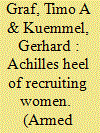

|
|
|
|
|
| Summary/Abstract |
The German Bundeswehr, like other NATO forces, seeks to recruit more women in order to improve its gender balance and to meet its personnel needs. However, previous research on military recruitment has paid little attention to women. Given that the (German) military is still a male-dominated organization, we argue that women’s opinion regarding the realization of gender equality in the military may very well be the Achilles heel of recruiting women. Based on the assumption that women value gender equality in the work environment, we test the hypothesis that women are more attracted to the military as a (potential) employer, the more they think the military has achieved gender equality. A multivariate analysis of nationally representative survey data from Germany from 2019 provides empirical evidence to support this hypothesis. Practical and theoretical implications are discussed.
|
|
|
|
|
|
|
|
|
|
|
|
|
|
|
|
| 2 |
ID:
001974
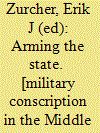

|
|
|
|
|
| Publication |
New York, I B Tauris, 1999.
|
| Description |
cii,168p.
|
| Standard Number |
186064404X
|
|
|
|
|
|
|
|
|
|
|
|
Copies: C:1/I:0,R:0,Q:0
Circulation
| Accession# | Call# | Current Location | Status | Policy | Location |
| 043101 | 355.223/ZUR 043101 | Main | On Shelf | General | |
|
|
|
|
| 3 |
ID:
061252
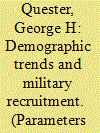

|
|
|
| 4 |
ID:
119637
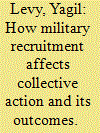

|
|
|
|
|
| Publication |
2013.
|
| Summary/Abstract |
This paper aims to advance the research on the conjunction of two fields-antiwar protest and casualty aversion-by offering a conceptual development of the role of military recruitment in affecting casualty sensitivity-incited antiwar mobilization. Scholars have shown that sensitivity to losses is not a constant variable. Its reflection in the public sphere is affected by variables clustered together as "the politics of war," such as sense of threat, mission success, number of casualties, and elite consensus, which can be mediated by collective actors. However, the role of the mode of military recruitment in influencing collective action in the military realm has been neglected. It is argued that the mode of military recruitment mediates collective actors' ability to leverage the politics of war to challenge dominant discourse and influence war policy, owing to the cumulative impact of four recruitment-related variables: republicanism, social power, the favoring of "voice," and bounded discourse. All shape the movement's framing and resources in a way that affects mobilization.
|
|
|
|
|
|
|
|
|
|
|
|
|
|
|
|
| 5 |
ID:
171015


|
|
|
|
|
| Summary/Abstract |
The success of military recruiting depends largely on the potential consequences of military services. This study examines how military service affects labor market outcomes of veterans. Specifically, I focus on how the Transition Assistance Program (TAP), a career assistance program, help military personnel transition to the civilian labor market. To identify the effects of TAP, I exploit variation in program accessibility generated by its initial rollout process. Using data from the Current Population Survey, I find that TAP improves the labor market outcomes of veterans, measured approximately ten years after separation. Specifically, it leads a significant increase in labor force participation. One possible mechanism is that TAP encourages the use of the GI Bill, a program that provides financial assistance to attend institutions of higher education.
|
|
|
|
|
|
|
|
|
|
|
|
|
|
|
|
| 6 |
ID:
189958
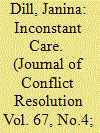

|
|
|
|
|
| Summary/Abstract |
The choice between protecting friendly soldiers or foreign civilians is a critical strategic dilemma faced in modern war. Prevailing theories suggest that casualties among both groups depress war support in Western democratic societies. Yet we know little about how ordinary citizens balance force protection and civilian casualty avoidance, and whether public opinion differs across Western democracies. Using survey experiments, we test three micro-foundations for what we call individuals’ “harm-transfer preferences:” self-interest, perception of soldiers’ consent to risk-taking, and nationalism. We find that respondents’ perception of soldiers’ consent and respondents’ nationalism explain individual-level variation in harm-transfer preferences. Moreover, Israeli citizens are significantly more likely than American or British citizens to prefer protecting friendly forces over avoiding foreign civilian casualties. This is associated with higher levels of nationalism and the perceptions that soldiers do not consent to risking their lives in Israel compared to the United States and the United Kingdom.
|
|
|
|
|
|
|
|
|
|
|
|
|
|
|
|
| 7 |
ID:
081059
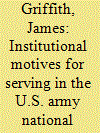

|
|
|
|
|
| Publication |
2008.
|
| Summary/Abstract |
The present study extended recent investigations of the motivations of American youth and active-duty soldiers to serve in the military. Unlike previous studies, this study employed a sample of reservists and examined their reasons for joining. Consistent with recent studies, institutionally-motivated soldiers were more likely to plan to remain in military service, would report for duty so they did not let their buddies and family down, and believed in the mission and service to the country. In contrast, materially-motivated soldiers were less likely to remain in reserve military service if deployed overseas, more likely to report for duty to meet contractual obligations and to avoid disciplinary actions, but less likely to report to serve the country. These factors have implications for the level of commitment and combat readiness of soldiers, in particular Army reservists, who are increasingly relied on for national defense strategy.
|
|
|
|
|
|
|
|
|
|
|
|
|
|
|
|
| 8 |
ID:
087836


|
|
|
|
|
| Publication |
2009.
|
| Summary/Abstract |
During the summer of 2007, public opinion in Israel was inflamed
over figures released by the IDF (Israel Defence Forces), according to
which 25 percent of potential Jewish male draftees do not take part in
military service, while the numbers among women are even higher
(about 40 percent). Furthermore, if one adds those men who do not
complete their service, the figure climbs to more than 40 percent.
These figures were at odds with the public and the military command's
expectations that the efforts to rehabilitate the army following the
weakness it had displayed in the Second Lebanon War (in the summer of
2006) would increase the motivation for recruitment.
|
|
|
|
|
|
|
|
|
|
|
|
|
|
|
|
| 9 |
ID:
108577


|
|
|
|
|
| Publication |
2011.
|
| Summary/Abstract |
Military conscription is a mechanism designed to develop troops and their capabilities,
which are the foundation for creating military strength, and it is inextricably related
to military manpower structure, military management system, and military structure.
Accordingly, we cannot ignore the implications of military service policies for
successful military reform and the transformation of military strength. Since
2006, Korea has been pursuing national defense reforms with a view to shifting
from a troop-focused quantitative military structure to a technology-intensive
military structure and has thus been carrying out a series of military service
reform plans. However, a rapid shift in policy direction and reasonable modifications
and adjustments of the implementation plan are constantly needed since the geostrategic and economic environment surrounding Korea, its demographic and social
environment, military technology development, and global trends in transforming
the military service system, continue to raise new issues related to Korean military
service policy. Modifications of the current military service system that would
allow for the increasing social demand for a change to all-voluntary service, a
review of a differentiated military service system designed to meet the need for the
adjustment of the term of military service for conscripts, the proposal of a reasonable
policy in response to the demands for mandatory military service for women, and
the creation of a plan to incorporate religiously motivated conscientious objectors
into the community service system will be an important part of the military service
policy agenda that national defense policymakers should keep in mind.
|
|
|
|
|
|
|
|
|
|
|
|
|
|
|
|
| 10 |
ID:
173895
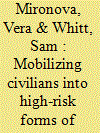

|
|
|
|
|
| Summary/Abstract |
We consider whether prior political activism increases the likelihood of engaging in higher-risk forms of violent collective action. We test our hypothesis in the context of the 2014 Euromaidan and subsequent separatist violence in Eastern Ukraine. In the aftermath of the Euromaidan protests, the Ukrainian government began a widespread campaign to mobilize young men for military service against separatist movements in the Donbas region amid escalating tensions with Russia. In July 2014, we survey young men who were volunteering to join the Ukrainian military’s counterinsurgency efforts and compare them to other young men who live in the same community but had not volunteered. Using a case control study design, we interviewed 100 young men who reported to a local Ukrainian army recruitment station in Kharkiv, a city in Eastern Ukraine which was an important center for military recruitment efforts. We compared them to 100 other young men who lived in the same communities, received recruitment notices, but had chosen not to report. Military recruits were sampled by cluster-sampling at the recruitment station, with random selection of recruits by cluster. Civilian males were sampled by random route in the vicinity of the recruitment station. When comparing survey responses between recruits and civilians, we find strong linkages between prior Euromaidan participation and military mobilization. Our results are robust to controls for parochial ethnocentrism and mere support for Euromaidan goals. Maidan participation and military mobilization are also correlated with a strong sense of self-efficacy, optimism, risk tolerance, patriotic nationalism, and feelings of in-group solidarity with protesters and the military. These correlates illustrate plausible mechanisms for how individuals could transition to increasingly higher-cost, higher-risk forms of collective action.
|
|
|
|
|
|
|
|
|
|
|
|
|
|
|
|
| 11 |
ID:
164524


|
|
|
|
|
| Summary/Abstract |
The Swiss Armed Forces are suffering from a structural deficit of militia officers despite good pay and a general supportive attitude in the population. Whereas, prior studies have focused on motivation to explain understaffing in armed forces, we offer an alternative approach based on opportunity cost. We model decision alternatives both within and outside a military organization, taking private sector employment as the reference point. We then monetize opportunity costs of leisure, fringe benefits, and private sector income not compensated. Our results suggest that in terms of opportunity cost, service as a militia officer is the least attractive option, an effect that we believe explains the persistent staff deficit. Implications of these findings for the literature and recruitment policy are discussed.
|
|
|
|
|
|
|
|
|
|
|
|
|
|
|
|
| 12 |
ID:
147117


|
|
|
| 13 |
ID:
185481
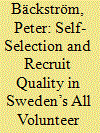

|
|
|
|
|
| Summary/Abstract |
This paper studies how local labour market conditions influence the quality composition of those who volunteer for military service in Sweden. A fixed-effects regression model is estimated on a panel data set containing IQ scores for those who applied for military basic training across Swedish municipalities during the period 2010 to 2016. The main finding is that low civilian employment rates at the local level tend to increase the mean IQ score of those who volunteer for military service, whereas the opposite is true if employment rates in the civilian labour market move in a more favourable direction. As such, the results suggest that the negative impact of a strong civilian economy on recruitment volumes is reinforced by a deterioration in recruit quality.
|
|
|
|
|
|
|
|
|
|
|
|
|
|
|
|
|
|
|
|
|